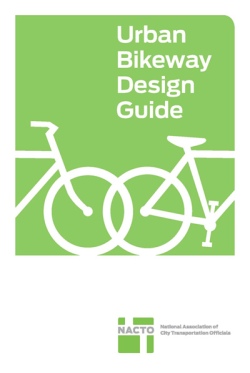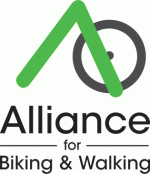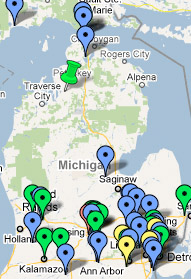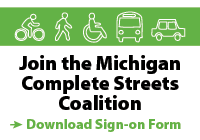You are currently browsing the monthly archive for September 2013.
 Earlier this month, Federal Highway Administration (FHWA) announced support for two guidelines, which can help communities, especially more urban ones, plan and design safe and convenient facilities for those who walk and/or bike.
Earlier this month, Federal Highway Administration (FHWA) announced support for two guidelines, which can help communities, especially more urban ones, plan and design safe and convenient facilities for those who walk and/or bike.
In the recent memorandum, the FHWA encourages its division throughout the nation to consider relying upon The National Association of City Transportation Officials (NACTO) Urban Bikeway Design Guide and the Institute of Transportation Engineers (ITE) Designing Urban Walkable Thoroughfares.
These guides build upon The American Association of State Highway and Transportation Officials (AASHTO) “green book”, which is the primary national resources for planning, designing, and operating bicycle and pedestrian facilities.
“The FHWA’s support for the NACTO guidelines gives communities and our state DOT an additional toolkit to help them provide safe and effective infrastructure that better serves bicyclists.” said John Lindenmayer, Advocacy & Policy Director for the League of Michigan Bicyclists. “Providing safe bicycle infrastructure that connects people to places goes along way to improve a bicyclists’ comfort level and overall feeling of safety on the road. These innovative bikeways certainly can play a big role in increasing ridership, which in and of itself, can help reduce the number of bicycle crashes within a community. It’s a win-win. This is an exciting opportunity for Michigan communities and LMB strongly encourages road agencies across the state to incorporate these design standards where appropriate.”
NACTO, which is an association of 15 major US cities (including Detroit) formed to exchange transportation ideas, insights, and practices and cooperatively approach national transportation issues, has published two editions of its bikeway design guide with with another edition set to be released on September 23, 2013. Unlike AASHTO’s more traditional guide, NACTO’s include protected bicycle lanes and other innovative best practices.
The FHWA memorandum also highlighted Michigan as a case study to illustrate use of treatments illustrated in the NACTO Guide by State or local DOTs:
Example 1: Michigan DOT’s Buffered Bike Lanes
One of the innovative bicycle facilities discussed in the NACTO Urban Bikeway Design Guide is buffered bike lanes. Buffered bike lanes create more space between motor vehicles and bicycles by delineating extra space between the bike lane and parked cars and/or a motor vehicle lane. Buffered bike lanes can be implemented if the pavement markings and channelizing devices are compliant with the MUTCD (see Bicycle Facilities and the Manual on Uniform Traffic Control Devices). Michigan DOT developed a video that describes their efforts to install buffered bike lanes in Oakland County (see Northwestern Highway Bicycle Lane: A Safer Place to Ride). Michigan DOT also developed a brochure that explains buffered bike lanes to the public (see What Every Michigan Driver Should Know About Bike Lanes).
 SEMCOG, a Michigan Complete Streets Coalition partner, is currently teaming up with MDOT on a regional nonmotorized plan for their seven county region, including Livingston, Macomb, Monroe, Oakland, St. Clair, Washtenaw, and Wayne Counties.
SEMCOG, a Michigan Complete Streets Coalition partner, is currently teaming up with MDOT on a regional nonmotorized plan for their seven county region, including Livingston, Macomb, Monroe, Oakland, St. Clair, Washtenaw, and Wayne Counties.
This planning process includes:
- Collection of all nonmotorized plans for the region (as well as nonmotorized components in Master Plans, Area Plans, Recreation Plans, Complete Streets Plans, etc);
- Digitization of all existing and proposed on-road and off road bicycle facilities into GIS data formats;
- A gap analysis for bike facilities and conceptual plan;
- Public involvement workshops and surveys; and
- A final plan with priority corridors for MDOT facilities and next steps for other road agencies.
To learn more about this regional nonmotorized plan and opportunities to provide public input, please visit SEMCOG’s nonmotorized page.
 Wednesday, September 25, 2013
Wednesday, September 25, 2013
2:00 PM to 3:00 PM eastern
Register online here
Cross-sector coalitions are powerful tools when working to pass and implement a state or local Complete Streets policy. By building partnerships with transit advocates, health stakeholders, economic development groups, environmental organizations and more, biking and walking advocates can multiply impact and ensure a great policy to build safe, accessible streets for all.
Join this call to hear from national and local advocates with hands-on experience building winning coalitions for Complete Streets.
Panelists will include:
- Stefanie Seskin, Deputy Director, National Complete Streets Coalition
- Zia Brucaya, Indiana Complete Streets Coalition Coordinator, Indiana Complete Streets Campaign
The Complete Streets Advisory Council will meet at 2 p.m., Thursday, Sept. 26, at the Capitol Commons Center, 400 S. Pine St., in Lansing. The meeting is open to the public.
The 18-member council was appointed in accordance with Public Act 135 of 2010. The group’s role, according to law, is to advise the State Transportation Commission (STC), county road commissions and municipalities on Complete Streets policies. A “complete street” refers to a roadway that provides appropriate access to all legal users, including motorists, bicyclists, pedestrians and those traveling by assistive devices, such as wheelchairs. The STC approved the Complete Streets policy in July 2012.
If you need special assistance to attend the Sept. 26 meeting, please contact Kim Young at 517-241-4819. The public also can submit comments in writing prior to the meeting to: Michelle Myers, Michigan Department of Transportation, Intermodal Policy Division, P.O. Box 30050, 425 W. Ottawa St., Lansing, MI 48909. Comments can be e-mailed to the [email protected] address.
Complete Streets Advisory Council members represent road and transit agencies, state agencies, walking and biking organizations, and environmental, senior citizens and disabled persons groups. More information is available online at: www.michigan.gov/completestreets.















